
When news of Land Rover’s all-new Defender dropped back in 2019, we were excited by the promise that the 110 wagon would start at around $75K. That would put it right in the middle of Toyota Prado territory and we figured we’d all be lining up to order one.
Since the L663 Defender arrived in Australia late in 2020, most of the ones we have driven have all been well past the $110,000 mark, and you can easily take that figure closer to $200K when you start ticking the option packages. For the record, the cheapest Defender 110 is the P300 petrol model which starts at $74,000, while the cheapest diesel is the D250 that we have here starting at $82,466. Even this car has crept up in price and it sits here at $99,596 as tested.
With the Prado getting a spec and price rise in the middle of 2021, we couldn’t resist the chance to line up this entry-level Defender with a top-of-the-range Prado which sells for $87,807+ORC, making them around the same money when you ignore the extras on the Landy.

LAND ROVER DEFENDER 110 D250
POWERTRAIN & PERFORMANCE
We've reviewed the D250 before and, despite being the lower output version of the 3.0-litre inline diesel six, we found its 570Nm and 183kW to be everything you need in a powerful touring 4x4. The extra power and torque of the D300 would be just cream on top, but you can’t get that engine in this base model.
The engine is smooth, quiet and very tractable, offering a steady supply of grunt through its rev range while waking up to a pleasant straight-six growl when you hold the throttle flat. The eight-speed automatic transmission is equally as pleasing; although, even after a couple of years of use, I still find the shifter less than user-friendly.
Officially the D250 is rated to return 7.9L/100km in the combined scale, while we achieved 11.38L/100km during our week of urban driving and on- and off-road testing.
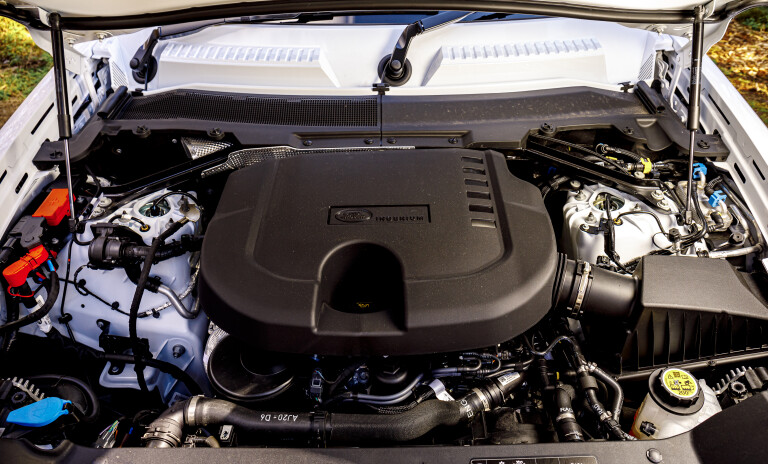
ON-ROAD RIDE & HANDLING
The base specification D250 comes on coil springs as standard, but we are yet to drive a 110 on coils. All the test cars have been fitted with the optional adjustable air-suspension kit which is a $1309 option and, we have to say, well-worth the extra money spent.
All L663 Defenders ride on independent suspension front and rear, and this gives superior on-road ride and handling to anything using a live axle. This set-up does a fine job of isolating the body from rough roads and irregularities in the surface, and it controls the vehicle over harsh corrugations better than anything with a live axle ever could.
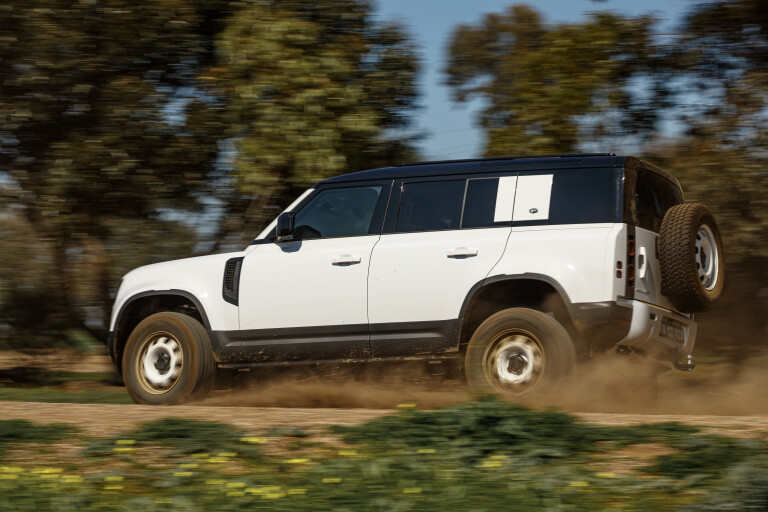
OFF-ROAD
We can only imagine that a Defender 110 on fixed-height coils would be compromised for ground clearance, and this is why we say the height-adjustable air suspension is a must-have option for anyone planning off-road use. Another essential option for driving off-road is the auto-locking rear differential, and it’s fitted on this vehicle as part of the $1663 Off Road option pack which also gets you black roof rails and a 240V-style power outlet in the cargo area. You can, however, just get the auto-locking diff on its own for $806.
This car is also fitted with all-terrain tyres on 18-inch steel wheels which are a no-cost option. The smaller diameter wheels are better suited to off-road use under any car and also improve the ride quality of the vehicle at the slight expense of on-road dynamics.
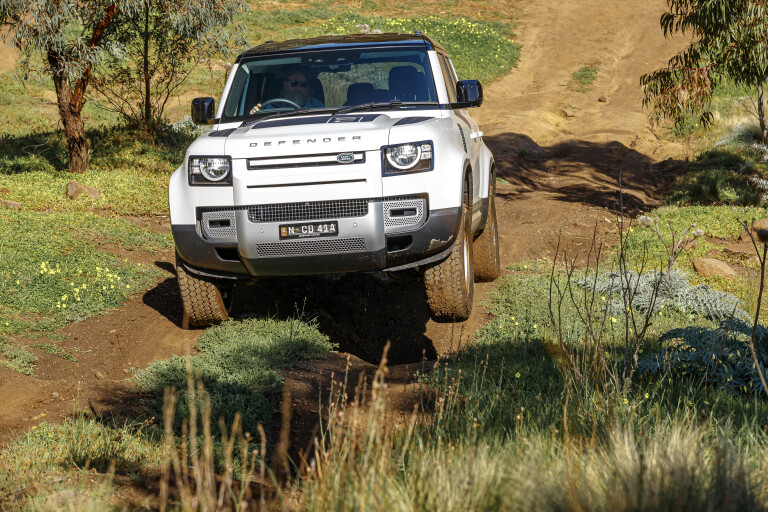
With the air suspension raised, the Defender has 291mm of ground clearance and 900mm of wading depth, which are up there with the best you’ll find in any production 4x4 wagon. The Defender walked up our steep and rutted hill climb, with the individual wheels dropping in to the holes to maintain grip on the track as it worked its way smoothly and without fail up the hill. Dialling in the Terrain Response 2 modes to suit the track sharpens up the chassis electronics to make them faster-reacting and the climb easier.
The air suspension drops back to its ‘normal’ ride height as vehicle speed gets past 80km/h, so you can leave it jacked-up while travelling on most off-road trails, but remember to raise it back up after a high-speed section on good roads. The ride quality does suffer a bit, getting harsh when touring in the raised setting, but the extra height is well-worth the rougher ride.
If we could improve on the Land Rover’s off-road systems at all, it would be to have the ability to manually lock both the centre and rear diffs when needed to ensure they remain locked – plus, we’d also add a locking front diff.
CABIN & ACCOMMODATION
For an entry-level model, the interior of the D250 doesn’t really lack anything you need. It looks more stripped out than most other vehicles such as the Prado Kakadu, but it has plenty of storage options and a modest-size AV screen with inbuilt sat-nav and wired CarPlay and Android connection.
This car is fitted with the $1853 front-centre ‘jump seat’ which gives you seating for six. A third-row pew to get seven seats is available as part of one of two option packs starting at $4796, but it also includes three-zone climate control air-con and cabin air-ioniser. You can’t have the jump seat and third-row.
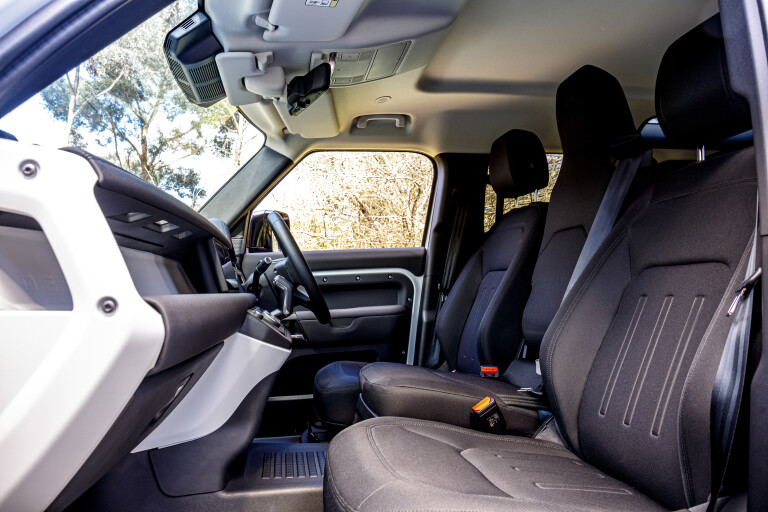
The number of seats you option depends on your needs, but we’d be more than happy with the standard five seats, leaving a big console between the front seats and the most available cargo space in the rear.
The cabin is spacious, airy and a great place to spend hours behind the wheel. It offers excellent vision through large windows which are great for off-road driving, plus there’s an array of cameras around the car for spotting, if that’s your thing. Some of the switchgear does takes a bit of getting used to, but spend the time to learn how it all works and it soon becomes second nature.
PRACTICALITIES
The Defender is nothing if not practical in every regard. It’s ease of use for general day-to-day driving make it easy to live with. The 3500kg towing capacity and 785kg payload are both up there for usefulness, as is 165kg dynamic roof-load capacity.
The second-row seats fold flat to leave a long useable cargo area, big enough for me (185cm tall) to sleep in, as I found on a cold, wet night in the mountains. There are tie-downs and more storage in the back, and either a 12 or 240V power outlet depending on the option pack. Without third-row seating, there’s also some useable storage space under the rear floor area.
There is a recovery point under the front of the vehicle, however it is concealed by a cover that you will want to remove before heading off-road. Aftermarket recovery points are available for the front and rear.
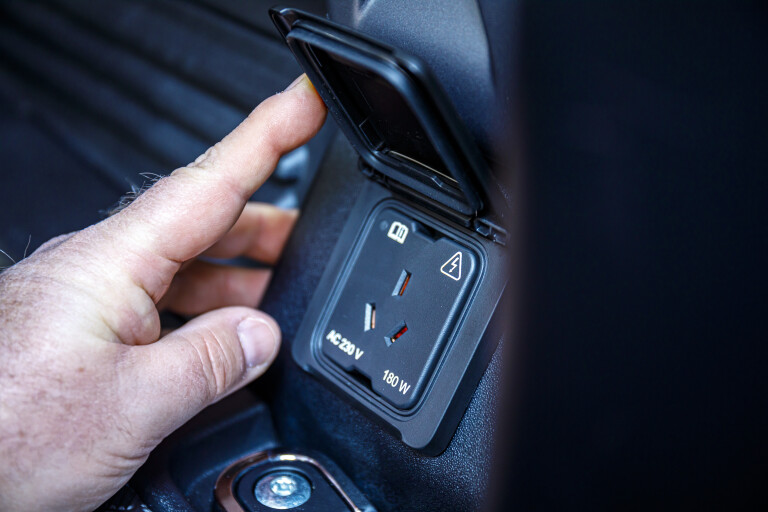
The aftermarket has been slow to develop kit for the L663 but there are things like lift rods, roof racks, switch panels and access ladders available. Land Rover offers some gear as well, including a front bar, Warn winch kit, roof racks and an intake snorkel.
The 255/70R18 tyre size isn’t massively common, but you should be able to fit the more common 265/65R18s as replacement if needed. The 89-litre fuel tank is acceptable but not as big as we’d like and certainly can’t match the150-litre available under a Prado.
TOYOTA LANDCRUISER PRADO KAKADU
POWERTRAIN & PERFORMANCE
The current generation of Prado has had a few engine options over its almost 20 years of service, but in 2021 it is powered exclusively by the 2.8-litre four-cylinder diesel that was upgraded in 2020 to put out 150kW and 500Nm of grunt. It needed this upgrade as the original iteration of the 1GD-FTV 2.8 engine was desperately lacking performance or inspiration.
Now the engine is well-suited to the Prado’s size and use, even if it can’t match the Land Rover six-cylinder engine for outputs or refinement. Prado’s Aisin six-speed automatic transmission has always been a good thing, and this drive hasn’t changed our opinion of it in any way.
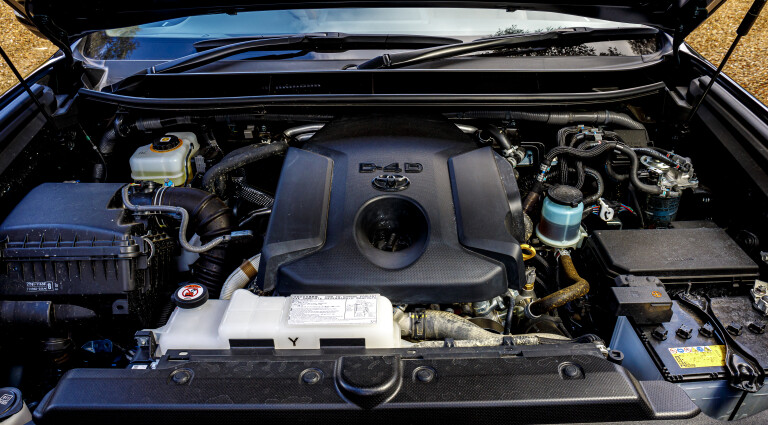
ON-ROAD RIDE & HANDLING
Compared to the Land Rover’s monocoque chassis and independent suspension, the Prado’s ladder-frame chassis and live rear axle are positively old-school designs and they very much determine the way the Toyota wagon drives. The Prado is a more traditional 4x4 wagon and feels more commercial in the way it handles and rides.
The suspension is soft and comfortable, but wallows and pitches and is less controlled than the more modern design that underpins the Defender. In this top-of-the-Prado-range Kakadu model, the suspension has variable dampeners which are height adjustable on the rear.
The rear axle might articulate well of road but on road, the old-school Prado still sways and lurches more than the Defender, and the Land Rover gives nothing away in wheel travel.
The body-on-frame design of the Toyota might not be great for dynamics but it does isolate the cabin well from road NVH, making the Kakadu a quiet and smooth place to cruise in.
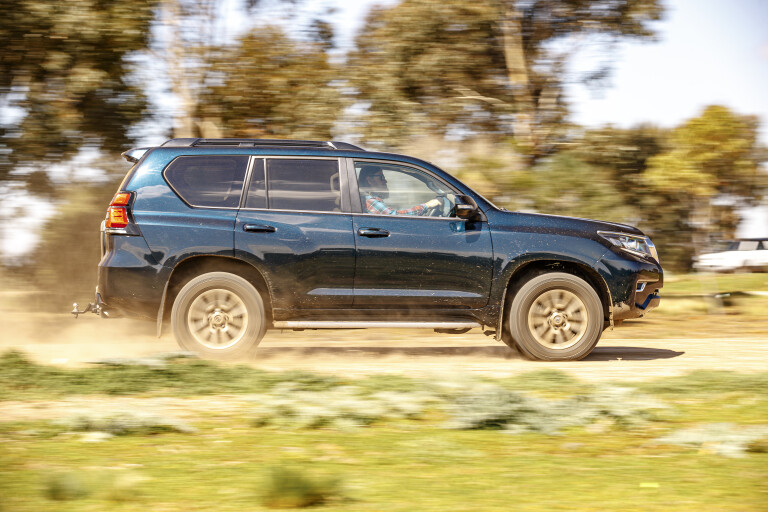
OFF-ROAD
The Prado shows its age and origins off-road as well as on. Sure, the live rear axle gives decent wheel travel at the back end, but the calibration of the electronic traction control (ETC) is slow and lets the car down once that wheel travel runs out and the tyres lose grip. This is different to newer Toyota 4x4s such as the Hilux, Fortuner and LC300, where the ETC calibration is fast acting and spot on; so we expect a lot more of the next generation Prado.
The Prado struggled on our set hill climb on the first attempt, relying only on the electronic traction control, but it made its way up with the rear diff lock engaged. Out of interest, we engaged the Crawl Control on its second of four speeds and the Prado inched its way up the hill easily. The descent was also much more controlled using the Crawl Control.
Crawl Control is like cruise control for off-road, in that it controls the speed via brakes and throttle input with the driver not using the brake and accelerator pedals at all. The milliseconds of throttle input gets drive to the wheels, with grip and more finesse than your right boot to get the car over obstacles. The system is a little noisy as the actuators cut in and out, but we’ve found the newer Crawl Control system in the LC300 has been made smoother and quieter with a larger pressure accumulator. Again, something else to look for in the next-gen Prado.

CABIN & ACCOMMODATION
With its cream leather, light-woodgrain interior trim, large glass sunroof and a dashboard loaded with silver switches and buttons, the Kakadu certainly looks like a top-spec model, as opposed to the more functional and basic look of the Defender. There’s even a refrigerated centre console to keep your drinks chilled, a premium JBL sound system and individual Blu-Ray players on the seat-backs to keep the kids entertained on trips. Both the front and second row of seats are heated, with the front seats cooled as well.
The Prado comes standard as a seven-seater, and the third-row pew folds up and down electronically at the push of a button. However, it does eat in to the cargo area of the Prado, which is only available as a five-seater in the entry-level GX grade.
The interior of the Kakadu is also a nice place to wile away the miles, but in a very different way to the Defender. It’s all about the luxury, while the Landy is all functionality.
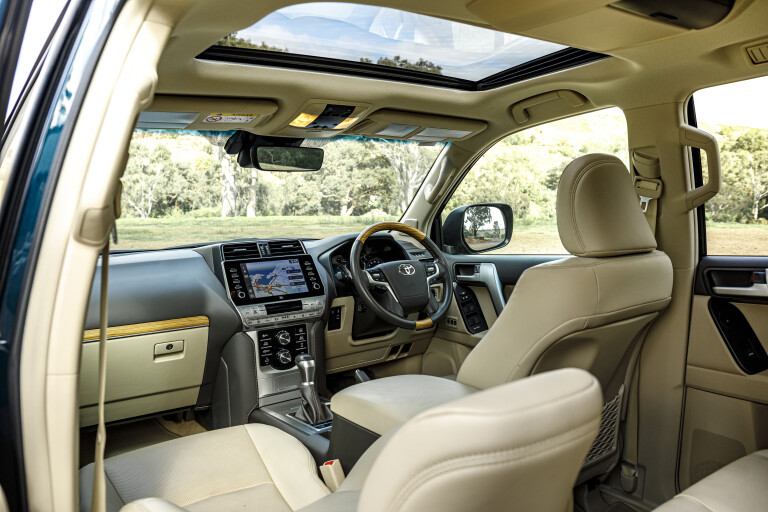
PRACTICALITIES
Being a long-running and extremely popular model, the Prado is extremely well-supported by the aftermarket accessories industry, as well as from Toyota genuine accessories. You can find all the gear to take your Prado anywhere and equip it for any expedition.
The Prado’s possible 150-litre fuel capacity is the best in the business, but this particular car was specified with the flat rear door which places the spare tyre under the back of the car where the auxiliary fuel tank would normally sit. This does clean up the look of the back of the Prado and makes the rear door lighter to open and close, but it does drop the fuel capacity down to a still-healthy 87 litres.
The most recent upgrade to the Prado Kakadu was limited to the addition of 19-inch alloy wheels replacing the 18s. These might look good on the soccer-mum run but are less than ideal for off-road use. In fact, we were contacted by a few new Kakadu owners who ordered their new cars when they were listed as having 18s but were ‘upgraded’ to the latest model on 19s, only to be disappointed to find they can’t get any light-truck tyres or many all-terrain options for their new car. The only option left to them is to buy another set of smaller diameter wheels.
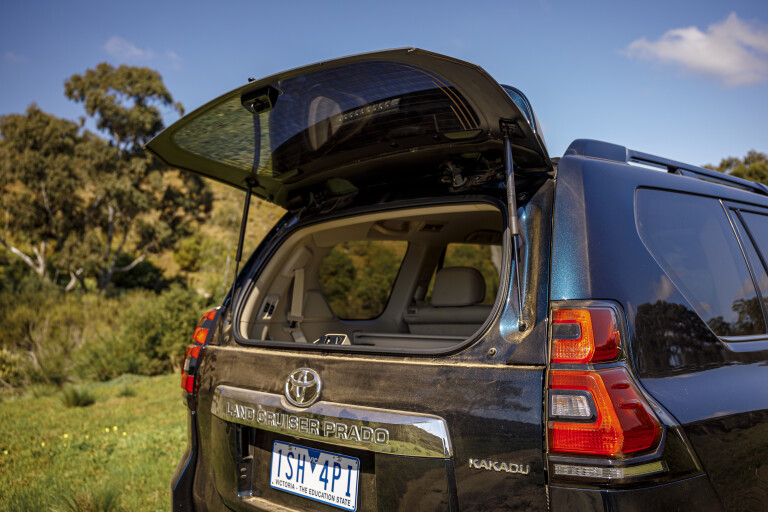
VERDICT
Let's not kid ourselves that comparing a top-of-the-range Prado with an entry-level Defender is a fair fight. The D250 misses out on a lot of the luxury features that the Kakadu gets as standard including heated and cooled, full power-adjustable leather seats, a power sunroof, a fridge in the console, an excellent JBL sound system, and 19-inch alloy wheels. Sure, you could get most those things in the Land Rover, but you’d be paying a lot more for them.
On the other hand, the D250 trumps the Kakadu in things that matter to four-wheel drivers such as a 3500kg towing capacity compared to 3000kg. It also wallops it in power with 183kW and 570Nm compared to 150kW and 500Nm. Plus it has more ground clearance, deeper wading depth, better on- and off-road driving performance, and greater interior space.
With its 18-inch steel wheels and extra ground clearance, you have to say that the Land Rover is better suited for off-road touring work; although, you’ll have a tougher time trying to find aftermarket accessories to fit to the new Defender. The Prado wins some more ground back with its excellent fuel capacity.

This Defender was fitted with a lot of factory options that bring the starting price up from $82,466 to $99,596 as tested. While most of them are styling and comfort extras, the two you really want are the height-adjustable air suspension and locking rear diff, which only brings the price up to $84,581 – still less than the Prado at $87,807. It even leaves some change for a few extras that are non-essential.
The Prado Kakadu feels like a top-spec model should, with all the bells and whistles; but the Defender doesn’t feel stripped out at all.
When you look at the two cars dollar for dollar, the Defender delivers a more modern vehicle that performs better on- and off-road, is more refined and has greater capacity than the Prado – so it’s a firm winner here. Of course, the Prado buyer could forgo some of the Kakadu’s luxury and bling items and buy a lower priced and specified model like a VX or GXL and still get the same mechanical package; and that’s something that the Defender can’t match.
LAND ROVER DEFENDER D250 110 S SPECS
| ENGINE | In-line 6-cyl turbo diesel |
|---|---|
| CAPACITY | 2996cc |
| MAX POWER | 183kW at 4000rpm |
| MAX TORQUE | 570Nm from 1250 to 2250rpm |
| TRANSMISSION | 8-speed automatic |
| CRAWL RATIO | 53.34:1 |
| 4X4 SYSTEM | Full-time 4x4 w/ high and low range |
| CONSTRUCTION | 5-door, 6-seat wagon, monocoque chassis |
| FRONT SUSPENSION | Independent height-adjustable air |
| REAR SUSPENSION | Independent height-adjustable air |
| WHEEL/TYRE | 18-inch steel / 255/70 |
| KERB WEIGHT | 2415kg |
| GVM | 3200kg |
| PAYLOAD | 785kg |
| TOWING CAPACITY | 3500kg |
| SEATING CAPACITY | 6 |
| FUEL TANK CAPACITY | 89L |
| ADR FUEL CLAIM | 7.9L/100km |
| ON-TEST FUEL USE | 11.38L/100km |
| DEPARTURE ANGLE | 40° |
| RAMPOVER ANGLE | 27.8° |
| APPROACH ANGLE | 37.5° |
| WADING DEPTH | 900mm |
| GROUND CLEARANCE | 291mm |
TOYOTA LANDCRUISER PRADO KAKADU SPECS
| ENGINE | In-line 4-cyl diesel |
|---|---|
| CAPACITY | 2755cc |
| MAX POWER | 150kW at 3000 to 3400rpm |
| MAX TORQUE | 500Nm at 1000 to 2800rpm |
| TRANSMISSION | 6-speed automatic |
| CRAWL RATIO | 36.11:1 |
| 4X4 SYSTEM | Full-time, dual-range 4x4 w/ locking centre and rear diffs |
| CONSTRUCTION | 5-door wagon on a ladder frame chassis |
| FRONT SUSPENSION | IFS w/ dual wishbones and coil springs |
| REAR SUSPENSION | Live axle on coil springs. Adjustable dampeners |
| TYRE | 265/55R19 |
| KERB WEIGHT | 2290kg |
| GVM | 2990kg |
| GCM | 5990 |
| PAYLOAD | 700kg |
| TOWING CAPACITY | 3000kg |
| SEATING CAPACITY | 7 |
| FUEL TANK CAPACITY | 87L (flat rear door as tested) |
| ADR FUEL CLAIM | 7.9L/100km |
| ON-TEST FUEL USE | 10.99L/100km |
| DEPARTURE ANGLE | 24° |
| RAMPOVER ANGLE | 22° |
| APPROACH ANGLE | 32° |
| WADING DEPTH | 700mm |
| GROUND CLEARANCE | 220mm |



COMMENTS